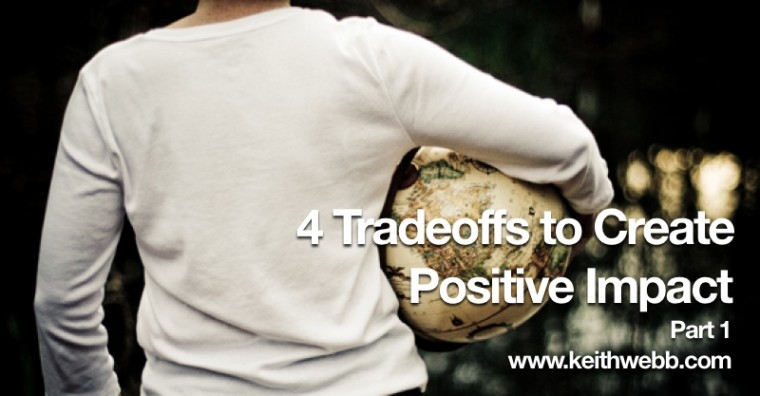“Changed lives,” Peter Drucker said, is the bottom line for the not-for-profit organization. To produce the sustained ability to change lives, you need purpose, effort, organization and money. Everything you do is a trade off between resources and results. Here are 4 scales I use to plan and make decisions to create sustainable positive impact.

Let me explain the four scales first, then I’ll show you how they interact.
1. Purpose
Purpose answers the question Why? Purpose is the bigger picture you seek to achieve. Regardless of whether you are a solopenuer or large organization you must know and maintain focus on your purpose.
For a solopeneur, your purpose will be closely related to your calling and giftedness. You can stray from your calling, to go after money, for example, but you cannot continue for long without having the life drained out of your work.
Purpose for organizations of all sizes means focusing on your niche, that segment of society you serve with your products and services. It’s tempting, and usually a mistake, to go after a different customer niche or produce unrelated products.
Stewarding the organization’s purpose is the CEOs most important responsibility.
2. Impact
Impact is what happens in the world because of your activities. My goal is to make an impact. That translates to specific behavioral changes that positively effect my clients’ lives and the lives of those around them.
Clients have told me that after applying the listening and questioning asking skills I teach in my coaching workshops, their marriages, work relationships, ministry results, and communication with their bosses and teenagers were transformed. That is the impact for which I’m working.
So, impact can be measured (even anecdotally) and predicted. If I hold a live workshop with a small group of people, I know it will produce a greater impact in their lives than would a downloadable video series.
3. Money
The term “non-profit” is actually a misnomer. Non-profit organizations do make money, even a profit. And that’s a good thing! It takes a continuous flow of money to keep the doors open and impact happening.
No money, no impact.
How about this: A lot of money, a lot of impact. Maybe. It’s not as simple as that. Money enables impact, but it doesn’t assure it. There are many more complex factors involved that determine impact.
Some things that generate positive impact cost very little money. Other things that produce the greatest impact require the greatest amount of money.
Non-profits must either earn or raise the money needed. The Money scale shows how much money can be generated (earned or raised) from the activity or product, minus how much it costs to produce it.
4. Ease
Ease is the amount of effort, organization, and staffing required to produce and maintain an activity. It’s admin. There’s a reason organizations are called “organizations.” We must organize to run them.
As my organization has grown, I’ve had to increasingly give my attention to running it. Even as a small operation I create and manage systems of planning, marketing, websites, personnel, income, and expenses for everything we do. This takes a lot of work. While I or someone else does this work, we cannot be doing other things. It also takes money to pay for these systems.
You can measure the Ease of organizing and producing something. Publishing a blog is relatively easy to administer. While a public workshop comes loaded with hands-on administrative work.
Positive Impact Scales
Everything you do, the services and products you provide, each rate differently on the four Positive Impact Scales.
It’s difficult to have all four scales high. Decisions are tradeoffs. Impact for Ease. Money for Impact. You can’t have it all.
Think of a public workshop. It’s highly related to my Purpose. The Impact is significant. It’s expensive to run, but generates good Money. The Ease is low, however, which means it will take a lot of work. Doing that work keeps me and my team from doing other work, which translates to lost Impact. That’s the real cost.
An online video course, on the other hand, is much easier to do because once it’s uploaded you don’t have to do much whether 5 people or 500 download it. A video course within my Purpose will produce less Impact and Money than a live workshop, but it will be much easier to do.
Consider this question: Which is better, producing 4 online video series or 1 public workshop?
While the initial Impact of just 1 online video series might be lower than a workshop, having 4 of them available to a significantly larger number of people might dwarf the Impact of a public workshop for the same amount of effort (Ease).
What about your work? How would you rate the activities you do? Which produce the most positive Impact within your Purpose for the resources used (Money, Ease).
Stop any activity that is outside your Purpose. Then look for the best ratio of Impact vs Money vs Ease. Let me know what you come up with.
Part 2 of this series is about 4 Strategies You Follow That Reduce Positive Impact. Part 3 is Coaching The Positive Impact Scales.
You can leave a comment by clicking here.



Please note: I reserve the right to delete comments that are offensive or off-topic. You own your comments but give me permission to use them. See My Comments Policy. Read my Permissions Policy to know how you can use my posts.